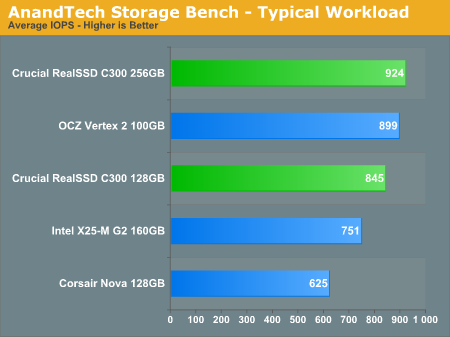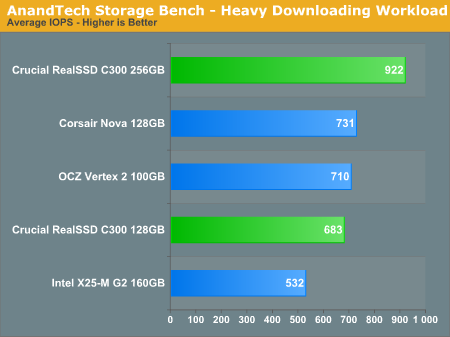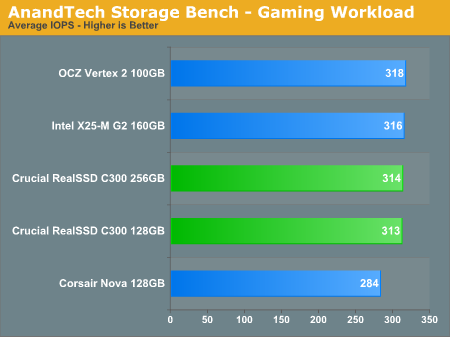The SSD Diaries: Crucial's RealSSD C300
by Anand Lal Shimpi on July 13, 2010 12:39 AM ESTAnandTech Storage Bench
The first in our benchmark suite is a light usage case. The Windows 7 system is loaded with Firefox, Office 2007 and Adobe Reader among other applications. With Firefox we browse web pages like Facebook, AnandTech, Digg and other sites. Outlook is also running and we use it to check emails, create and send a message with a PDF attachment. Adobe Reader is used to view some PDFs. Excel 2007 is used to create a spreadsheet, graphs and save the document. The same goes for Word 2007. We open and step through a presentation in PowerPoint 2007 received as an email attachment before saving it to the desktop. Finally we watch a bit of a Firefly episode in Windows Media Player 11.
There’s some level of multitasking going on here but it’s not unreasonable by any means. Generally the application tasks proceed linearly, with the exception of things like web browsing which may happen in between one of the other tasks.
The recording is played back on all of our drives here today. Remember that we’re isolating disk performance, all we’re doing is playing back every single disk access that happened in that ~5 minute period of usage. The light workload is composed of 37,501 reads and 20,268 writes. Over 30% of the IOs are 4KB, 11% are 16KB, 22% are 32KB and approximately 13% are 64KB in size. Less than 30% of the operations are absolutely sequential in nature. Average queue depth is 6.09 IOs.
The performance results are reported in average I/O Operations per Second (IOPS):

In our custom test suite we can finally put to rest concerns about the real world behavior of SandForce’s drives. Our light test case makes it pretty clear: in practice the Vertex 2 performs within 3% of the 256GB C300, and is a good 20% faster than the Intel X25-M G2. Keep in mind that we’re looking at raw IO performance and not total system performance here.
If there’s a light usage case there’s bound to be a heavy one. In this test we have Microsoft Security Essentials running in the background with real time virus scanning enabled. We also perform a quick scan in the middle of the test. Firefox, Outlook, Excel, Word and Powerpoint are all used the same as they were in the light test. We add Photoshop CS4 to the mix, opening a bunch of 12MP images, editing them, then saving them as highly compressed JPGs for web publishing. Windows 7’s picture viewer is used to view a bunch of pictures on the hard drive. We use 7-zip to create and extract .7z archives. Downloading is also prominently featured in our heavy test; we download large files from the Internet during portions of the benchmark, as well as use uTorrent to grab a couple of torrents. Some of the applications in use are installed during the benchmark, Windows updates are also installed. Towards the end of the test we launch World of Warcraft, play for a few minutes, then delete the folder. This test also takes into account all of the disk accesses that happen while the OS is booting.
The benchmark is 22 minutes long and it consists of 128,895 read operations and 72,411 write operations. Roughly 44% of all IOs were sequential. Approximately 30% of all accesses were 4KB in size, 12% were 16KB in size, 14% were 32KB and 20% were 64KB. Average queue depth was 3.59.

Our heavy downloading workload involves more heavily compressed files and thus we see the Vertex 2 perform like a 128GB C300. The 256GB C300 just can't be touched.
The gaming workload is made up of 75,206 read operations and only 4,592 write operations. Only 20% of the accesses are 4KB in size, nearly 40% are 64KB and 20% are 32KB. A whopping 69% of the IOs are sequential, meaning this is predominantly a sequential read benchmark. The average queue depth is 7.76 IOs.

Our gaming workload has been SATA bound for the high end SSDs for some time now. If you happen to be baller enough to play games off of an SSD, any of these high end drives will perform the same. Although our custom tests don't work with the 6Gbps Marvell controller, the boost to sequential read speed should be quite visible in gaming workloads with the C300.










51 Comments
View All Comments
Breit - Wednesday, July 14, 2010 - link
yes, a sandforce drive should be slower in general when used with third party encryption as all data seems random to the drive then and the compression algorithms have nothing to compress. i'm not sure if the sf1200 controller can, but the sf1500 controller definitely can encrypt the data on the drive by themself storing it in an aes-128 encrypted format.quote from the sandforce site:
"DuraClass technology automatically stores data in a secure, AES-128 encrypted format. This also prevents would-be thieves from extracting data directly from the flash memory should they ever have access to the drive."
(http://www.sandforce.com/index.php?id=21&paren...
question is how good or usable their implementation is?! :)
sparkuss - Tuesday, July 13, 2010 - link
I asked this question in a previous review and once again you note your "using the Marvell 88SE9128 controller similar to many motherboards".Did you only use the WIN7 MSAHCI and INTEL IMSM 8.9 on both the onboard SATA2 and Rocket 620?
This is of interest to many on the Crucial boards concerning the lack of TRIM support in Marvell drivers for their 9123/9128 controllers.
mattgmann - Tuesday, July 13, 2010 - link
last year the ssd market was pretty cut and clear with what was good and what wasn't. There have been a lot of advances recently, and it's getting hard to keep track of what manufacturers with what controllers work well in what configurations. I'd really love to see an SSD buying guide with all of the current drives, possibly separated into workstation, laptop, and server use sections.thanks
willscary - Tuesday, July 13, 2010 - link
I just sent my first SSD back to Crucial. I called. They RMA'ed me and will send a replacement ASAP. I am impressed. I have 5 year warranties on the M225 series SSDs, and they never even blinked...send it back and they will replace it.This was the only M225 that I have installed that does not have 1916 firmware.
My comment is on the prices. If any of you recall, I was the guy who already had bought, installed and used 5 Crucial M225 128GB SSDs when I decided to try Sandforce in the OWC SSD. After I bought the SSD and ON THE DAY IT SHIPPED, OWC changed their website and said that the controllers were Sandforce 1200 and not the 1500 that I was told when I puurchased. It was still a good deal, but I was upset with the bait and switch, so I refused delivery and had it returned.
I then purchased a Crucial M225 for myself, this one the 256GB flavor.
I want to say that I have had no problems. Peak reads reach about 240MB/s and average reads are about 215MB/sec with large files. Writes are less, about 175-180MB/sec for larger files. With small files like Anand uses, my writes are about 125MB/sec and my small file reads are about 145MB/sec.
Very small files read and write much slower, in the 5-25MB/sec range, but those are files that are very small...in the 4-20KB range.
What amazes me is the speed. While 5MB/sec may sound slow, it is not, at least when you consider that these are 4KB files. These small files write and read nearly instantly.
I paid $525 for the drive. I have seen them as low as $509. This is a great price! Now that I have seen the newest article here by Anand, I really understand that my outdated M225 is still a great deal at $525.
I would like to see this drive, or a comparable one, listed in the lineup with these newer drives. While not as fast, I believe them to be a good value when sale priced. I even saw a Western Digital 128GB SSD a few weeks ago for $219 with free shipping. They were gone very quickly!
Makaveli - Tuesday, July 13, 2010 - link
That was a good read thanks.pesos - Tuesday, July 13, 2010 - link
Hi Anand,Thanks for the followup review - I have been using a 256gb C300 on each of my Poweredge T710 servers for the last few months with great results.
I am curious - does applying the destructive firmware update restore the drive to peak performance, or should it be coupled with some kind of secure erase?
Thanks,
Wes
elimliau - Wednesday, July 14, 2010 - link
Hi,Has anyone made the above work, mine cant?
Regards,
elimliau
sparkuss - Wednesday, July 14, 2010 - link
elimliau,You need to head over to the Crucial SSD forum. I have seen several threads and posts on that specific card/board.
http://forum.crucial.com/t5/Solid-State-Drives-SSD...
sparkuss - Wednesday, July 14, 2010 - link
EDIT: You may have to register to get that link to work, sorryfoo-bar - Friday, July 16, 2010 - link
This is all very interesting, and new SSDs seems to hit the market constantly. But the differences seems to be mostly software related i.e firmware. What are the bottleneck to get full SATA speed? Is it the NAND flash them selves? And if so, what is on the horizon when it comes to this type of memory?